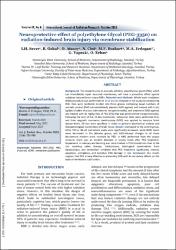| dc.contributor.author | Sever, I. H. | |
| dc.contributor.author | Özkul, Bahattin | |
| dc.contributor.author | Atasoy, Özüm | |
| dc.contributor.author | Cini, Nilsu | |
| dc.contributor.author | Bozkurt, Mehmet Fatih | |
| dc.contributor.author | Erdogan, M. A. | |
| dc.contributor.author | Yaprak, G | |
| dc.contributor.author | Erbaş, Oytun | |
| dc.date.accessioned | 2024-02-29T12:10:19Z | |
| dc.date.available | 2024-02-29T12:10:19Z | |
| dc.date.issued | 2023 | en_US |
| dc.identifier.citation | Sever, Ibrahim & Özkul, Bahattin & Atasoy, Özüm & Cini, Nilsu & Bozkurt, Mehmet & Erdoğan, M. & Yaprak, Gökhan & Erbas, Oytun. (2023). Neuroprotective effect of polyethylene Glycol (PEG-3350) on radiation-induced brain injury via membrane stabilization. 21. 733-743. 10.52547/ijrr.21.4.19. | en_US |
| dc.identifier.uri | https://hdl.handle.net/20.500.12900/321 | |
| dc.description.abstract | Background: This research aims to evaluate whether polyethylene glycol (PEG), which can immediately repair neuronal membranes, will have a protective effect against radiation-induced brain injury (RIBI). Materials and Methods: Whole brain irradiation (RAD) procedure was performed on 14 of 21 rats included in the study for establishing RIBI. Rats were randomly divided into three groups containing equal numbers of animals: control (RAD not established), placebo (RAD applied, and treated with 1 ml/ kg/day of saline that was administered intraperitoneally), and treatment (RAD applied, and treated with 30 mg/kg /day of PEG 3350 that was administered intraperitoneally). Following the end of the 22-day treatments, behavioral tests were performed first, and then magnetic resonance spectroscopy (MRS) was applied to measure brain lactate levels. All rats were sacrificed in order to perform biochemical analysis and histopathological examination of brain tissue. Results: Compared to the control group, MDA, TNF-alpha, NF -KB and lactate levels were significantly increased, while BDNF levels were decreased in the placebo group; and RAD-induced changes in all these biochemical markers were reversed by PEG. In MRS performed from the corpus striatum, there was an evident decrease in lactate levels after PEG treatment. Impairment in memory and learning was more limited in PEG-treated rats than in the rats receiving saline therapy. Furthermore, histological examinations from hippocampus and cerebellum exhibited that PEG treatment significantly reduces apoptosis, astrogliosis, and oxidative DNA damage in rats. Conclusion: Our results support that PEG is very effective in preventing RIBI with its secondary effects on the basis of membrane stabilization. | en_US |
| dc.language.iso | eng | en_US |
| dc.publisher | IJRR - International Journal of Radiation Research | en_US |
| dc.relation.isversionof | 10.52547/ijrr.21.4.19 | en_US |
| dc.rights | info:eu-repo/semantics/openAccess | en_US |
| dc.subject | Radyasyon | en_US |
| dc.subject | Radiation | en_US |
| dc.subject | PEG-3350 | en_US |
| dc.subject | MRS | en_US |
| dc.subject | 8-oxo-dG | en_US |
| dc.subject | BDNF | en_US |
| dc.subject | Membran stabilizasyonu | en_US |
| dc.subject | Membrane stabilization | en_US |
| dc.title | Neuroprotective effect of polyethylene Glycol (PEG-3350) on radiation-induced brain injury via membrane stabilization | en_US |
| dc.type | article | en_US |
| dc.department | İstanbul Atlas Üniversitesi, Meslek Yüksekokulu, Tıbbi Görüntüleme Teknikleri Ana Bilim Dalı | en_US |
| dc.authorid | Bahattin Özkul/0000-0003-3339-8329 | en_US |
| dc.contributor.institutionauthor | Özkul, Bahattin | |
| dc.identifier.volume | 21 | en_US |
| dc.identifier.issue | 4 | en_US |
| dc.identifier.startpage | 733 | en_US |
| dc.identifier.endpage | 743 | en_US |
| dc.relation.journal | International Journal of Radiation Research | en_US |
| dc.relation.publicationcategory | Makale - Uluslararası Hakemli Dergi - Kurum Öğretim Elemanı | en_US |

















